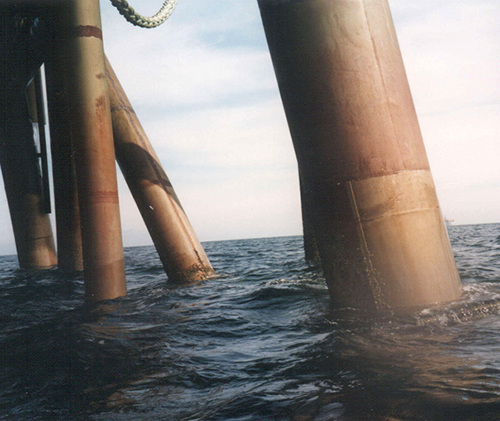 Copper-nickel sheathing as corrosion protection in the splash zone
Copper-nickel sheathing as corrosion protection in the splash zone90-10 and 70-30 copper-nickels were originally developed for naval condensers and piping. Today, copper-nickels have an established reputation for handling seawater in a wide range of conditions and applications.
Their corrosion resistance is achieved by the formation of a complex surface film which develops by an interaction with the seawater itself, thereby protecting the metal below it. General corrosion rates for 90-10 and 70-30 Cu-Ni alloys in seawater range between 0.025 and 0.0025 mm/yr. For a majority of applications, these rates enable the alloys to last the service lifetime.
Of the wrought copper alloys, copper-nickels have the best resistance to seawater flow velocity. As with all copper alloys, it is important that flow rates remain below the recommended design velocity to avoid erosion corrosion. In defined conditions of pipework, the maximum flow rate for 90-10 Cu-Ni is normally about 3.5m/s. In more open structures, the hydrodynamic conditions are different and the flow rate before the initiation of erosion can be much higher.
Copper-nickels are not sensitive to chloride attack as nickel-containing stainless steels might be. They have high resistance to chloride pitting, crevice corrosion, stress corrosion cracking, even at elevated temperatures. Ammonia stress corrosion cracking, which copper-zinc brass alloys can be susceptible to, is not found with copper-nickels in seawater.
Exposure to sulfides should be restricted, particularly while the protective oxide film is maturing.
Copper-nickel alloys fall in the middle of the galvanic series. As with all bimetallic coupling, unfavorable galvanic combinations should be avoided or standard preventative measures taken.
Contents
- Surface Film: Formation of a thin protective surface film is necessary to ensure corrosion resistance.
- General Corrosion Rates: Corrosion rates decrease over years after the formation of a good surface film.
- Localized Corrosion: Information on resistance to chloride pitting, crevice corrosion, stress corrosion cracking, hydrogen embrittlement; dealloying and hot spot corrosion; impact of ammonia.
- Pitting and Crevice Corrosion: Resistance factors, penetration rates, comparison to other materials.
- Stress Corrosion Cracking: Resistance to stress corrosion cracking is advantageous for use in air removal sections.
- Velocity Effects: Information on acceptable flow rates for 90-10 and 70-30 Cu-Ni in condensers, heat exchangers, pipeline systems, firemains; preferred alloys for MSF plants; experience with ship hulls.
- Sand Erosion: Sand loadings, effect of particle size, and C71640 for heavy loadings.
- Galvanic Properties: Properties, effects, and guidelines for splash zone sheathing and boat hulls.
- Sulfides Corrosion: Polluted and sulfate-reducing waters can experience the corrosive influence of sulfides. Links to references on this subject.
- Seawater Treatments: Ferrous sulfate and chlorination.
- Corrosion in Condenser and Heat Exchange Systems: Full-length paper about corrosion resistance in condensers and heat exchange systems.
Interactive Presentation
Visit our Interactive Presentation for a visual overview of 90-10 and 70-30 Cu-Ni properties, corrosion resistance, biofouling behaviour, applications and guidelines to achieve optimum service.
Additional References: General corrosion, ammonia corrosion, localized corrosion, chlorination corrosion, sand erosion, sulfide corrosion and velocity effects.
References
- Application of Copper Nickel UNS C70600 for Seawater Service, Wilhelm Schleich, Paper No 5222, , CORROSION/2005, Houston, NACE International.
- Copper Alloys in Seawater: Avoidance of Corrosion, Roger Francis, Publication 225, pp 20, , CDA UK.
- Copper-Nickel Alloys for Seawater Corrosion Resistance and Antifouling - A State of the Art Review, C.A. Powell and H.T. Michels, , Corrosion 2000, NACE International.
- Copper-Nickel Alloys Resistance to Corrosion and Biofouling, Powell, C. A. and Michels, H. T., Seminar Technical Report, 7044-1919, , Corrosion 2000, NACE, Original title: The Application of Copper Nickel Alloys in Marine Systems.
- Protection of Seawater System Pipework and Heat Exchanger Tubes in HM Surface Ships and Submarines in Sea Water Systems, Standard 02-781 Issue 2, , UK Ministry of Defence, Not available online but inquiries can be sent to the DStan Helpdesk at enquiries@dstan.mod.uk.
- Copper Nickel Condenser and Heat Exchanger Systems, Kirk, W. and Tuthill, A, Technical Report 7044-1919, , CDA Inc Seminar The Application of Copper-Nickel Alloys in Marine Systems.
- The Development of Very High Strength Copper Alloys with Resistance to Hydrogen Embrittlement and Stress Corrosion Cracking, C.D.S. Tuck, , Corrosion/2005 Annual Conference and Exhibition, Houston, ©NACE.
- Typical Failures of 90/10 CuNi Sea water Tubing Systems and How to Avoid Them, Schleich, Wilhelm, , Eurocorr 2004, NACE.
